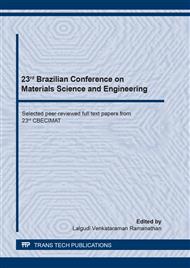p.37
p.43
p.51
p.57
p.62
p.67
p.73
p.79
p.84
Influence of the Order of Incorporation of Sulfur in the Mechanical Properties of Vulcanized Nr Compounds
Abstract:
The objective of this work was to evaluate the influence of the order of sulfur addition on the mechanical properties of vulcanized natural rubber compounds. The addition of sulfur was carried out by two methodologies: (I) sulfur was added at the beginning of the mastication process, and (II) sulfur was added at the end of the mixing process. The compounds were obtained in open cylinder, and vulcanized in a press at 150°C. The vulcanization parameters were determined by rheometry, where as the mechanical properties were evaluated by testing samples for their tensile strength, tear strength, resilience, and Shore-A hardness. The dimensional stability of the vulcanized samples was also evaluated experimentally, by comparing specimens not heat-treated to those submitted to 100°C for 4 hours. Comparing the results of method (I) to method (II), the results, indicate that the addition of sulfur at the beginning of the mastication process (method I) yielded increases of 20 and 11% in tensile strength and tear strength, respectively, followed by a 9% increase in hardness, and 6% in resilience, without significant losses in maximum elongation. The dimensional stability test showed a reduction of 75% in the contraction for the vulcanized samples which had sulfur addition at the beginning of the mastication process of the unvulcanized NR rubber.
Info:
Periodical:
Pages:
62-66
Citation:
Online since:
October 2020
Keywords:
Price:
Сopyright:
© 2020 Trans Tech Publications Ltd. All Rights Reserved
Share:
Citation:


